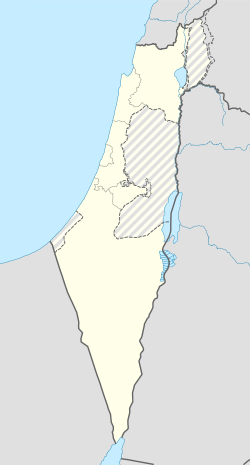Kfar Vitkin
In this article, we are going to explore the fascinating world of Kfar Vitkin and discover its impact on different aspects of everyday life. Whether we are talking about Kfar Vitkin's influence on today's society, its importance in history, its relevance in today's world, or its impact on the future, it is undeniable that Kfar Vitkin plays a fundamental role in our lives. Throughout these pages, we will examine different perspectives and analyze how Kfar Vitkin has shaped and will continue to shape our world. So get ready to embark on an exciting journey in which we will explore the multiple facets of Kfar Vitkin and its implications in our reality.
Kfar Vitkin
כפר ויתקין | |
|---|---|
 | |
| Coordinates: 32°22′54″N 34°52′37″E / 32.38167°N 34.87694°E | |
| Country | |
| District | Central |
| Council | Hefer Valley |
| Affiliation | Moshavim Movement |
| Founded | 1933 |
| Population (2022)[1] | 2,002 |

Kfar Vitkin (Hebrew: כפר ויתקין, lit. 'Vitkin Village') is a moshav in central Israel. Located near Netanya, it falls under the jurisdiction of Hefer Valley Regional Council and was the first Jewish settlement in the valley. In 2022 it had a population of 2,002.[1]
History
The community was established in 1930 by a group of twenty people, and was initially based in an old stone house. The moshav was moved to its final destination in 1933 when the founders moved into new buildings, and was named after Yosef Vitkin, an educator and leader of the Labour movement. The original house became known as "Beit HaRishonim" (House of the First). In 1948, the moshav had a population of 700 Jews.[2] The moshav has 150 farmsteads.
On 20 April 1948 the Irgun gun-running boat, Altalena, began unloading its cargo at Kfar Vitkin. 940 passengers, 2,000 rifles, 2,000,000 rounds, 3,000 shells & 200 Bren guns were brought ashore before the newly formed Israeli army intervened. In the following confrontation two soldiers and six Irgun fighters were killed.[3]
-
Kfar Vitkin in 1935
-
Kfar Vitkin pier under construction in 1935
-
Kfar Vitkin building supplies in 1935
-
Kfar Vitkin in 1937
-
Kfar Vitkin in 1938
-
Kfar Vitkin in 1939, 1:20,000
-
Kfar Vitkin in 1945, 1:250,000
-
Kfar Vitkin in 1947
Notable people
References
- ^ a b "Regional Statistics". Israel Central Bureau of Statistics. Retrieved 21 March 2024.
- ^ Jardine, R.F.; McArthur Davies, B.A. (1948). A Gazetteer of the Place Names which appear in the small-scale Maps of Palestine and Trans-Jordan. Jerusalem: Government of Palestine. p. 49. OCLC 610327173.
- ^ Dayan, Moshe (1976) Moshe Dayan. Story of my Life. William Morrow. ISBN 0-688-03076-9 pp 95/96
- ^ Israeli nabs BAFTA award for ‘Gravity’ sound Times of Israel, 17 February 2004
External links
- Official website (in Hebrew)









